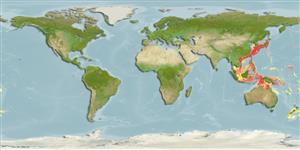Classification / Names
ชื่อสามัญ | ชื่อพ้อง | Catalog of Fishes(สกุล, ชนิด) | ITIS | CoL | WoRMS | Cloffa
sub class Elasmobranchii (ฉลามและกระเบน) (sharks and rays) >
Carcharhiniformes (Ground sharks) >
Scyliorhinidae (Cat sharks) > Scyliorhininae
Etymology: Cephaloscyllium: cephalus, from kephale (Gr.), head, referring to its very broad and depressed head; skylion, Greek for dogfish or small shark. (See ETYFish); umbratile: Latin for shaded, described as “marbled above with shades of dark and deep brown”. (See ETYFish).
More on authors: Jordan & Fowler.
Environment: milieu / climate zone / depth range / distribution range
นิเวศวิทยา
เกี่ยวกับทะเล,น้ำเค็ม เกี่ยวกับหินโสโครก; ระดับความลึก 20 - 500 m (Ref. 94801). Subtropical
Western North Pacific: Japan Sea, East China Sea (Japan, Korea, China and Taiwan) (Ref. 94801); possibly up to New Zealand. Similar to Cephaloscyllium isabellum but the color pattern is different.
Length at first maturity / ขนาด / น้ำหนัก / Age
Maturity: Lm 97.9, range 92 - 104 cm
Max length : 120 cm TL เพศผู้/กระเทย; (Ref. 95495); 110.0 cm (female)
Short description
สัณฐานวิทยา | ความยาวต่างๆ
This species is distinguished by the following characters: with three broad dark saddle blotches before first dorsal fin, the first saddle on posterior half of interorbital region and immediately behind eye, second saddle over pectoral fin base, and third saddle at middle between pectoral
and pelvic fin bases; adults with dark and irregular spots, sometimes with white spots between the saddles (Ref. 94801).
Found on rocky reefs (Ref. 12951); near shore, down to 300 m on sandy mud bottoms (Ref. 11230). Feeds mainly on bony fishes such as mackerel, sardines, filefishes, moray eels, dragonets, flatfishes and cowfishes (Ref. 12951) but also preys on elasmobranches and squid (Ref. 12951). Oviparous (Ref. 50449). Thrives and breeds in public aquariums (Ref. 12951).
Life cycle and mating behavior
วัยเจริญพันธุ์ | การสืบพันธุ์ | การวางไข่ | เซลสืบพันธ์ของเพศเมีย(ไข่) | ความดกของไข่ | ตัวอ่อน
Oviparous (Ref. 559), two tendril eggcases are deposited at one time (Ref. 12951). Embryos feed solely on yolk (Ref. 50449). Eggs hatch after about 1 year and size upon hatching is 16-22 cm (Ref. 12951).
Nakaya, K., S. Inque and H.-C. Ho, 2013. A review of the genus Cephaloscyllium (Chondrichthyes: Carcharhiniformes: Scyliorhinidae) from Taiwanese waters. Zootaxa 3752(1):101-129. (Ref. 94801)
IUCN Red List Status (Ref. 130435)
Human uses
สถานที่แสดงสัตว์และพืชน้ำ: สถานแสดงสัตว์น้ำของรัฐ
ข้อมูลเพิ่มเติม
ชื่อสามัญชื่อพ้องกลไกการเผาผลาญพลังงานผู้ล่าการศึกษาเกี่ยวกับผลกระทบของสารประกอบทางเคมีที่เป็นอันตรายต่อสิ่งมีชีวิต ประชากร และสิ่งแวดล้อมการสืบพันธุ์วัยเจริญพันธุ์การวางไข่การรวมกลุ่มวางไข่ความดกของไข่เซลสืบพันธ์ของเพศเมีย(ไข่)Egg development
Age/SizeการเจริญเติบโตLength-weightLength-lengthLength-frequenciesความยาวต่างๆสัณฐานวิทยาตัวอ่อนพลวัตของสัตว์น้ำวัยอ่อนการทดแทนที่อุดมสมบรูณ์BRUVS
อ้างอิงการเพาะเลี้ยงสัตว์น้ำประวัติการเพาะเลี้ยงสัตว์น้ำสายพันธุ์พันธุศาสตร์ElectrophoresesอัตราพันธุกรรมโรคการแปรรูปNutrientsMass conversion
ผู้ร่วมมือรูปภาพหลายรูปStamps, Coins Misc.เสียงปลามีพิษ เช่น ปลาปักเป้าความเร็วรูปแบบการว่ายน้ำพื้นที่เหงือกOtolithsสมองวิสัยทัศน์
เครื่องมือ
Special reports
Download XML
แหล่งที่มาจากอินเตอร์เน็ต
Estimates based on models
Preferred temperature (Ref.
123201): 11.5 - 26.5, mean 19.2 °C (based on 435 cells).
Phylogenetic diversity index (Ref.
82804): PD
50 = 0.5000 [Uniqueness, from 0.5 = low to 2.0 = high].
Bayesian length-weight: a=0.00263 (0.00139 - 0.00497), b=3.21 (3.04 - 3.38), in cm total length, based on LWR estimates for this (Sub)family-body shape (Ref.
93245).
ระดับชั้นอาหาร (Ref.
69278): 4.5 ±0.76 se; based on food items.
ความสามารถในการกลับคืนสู่ปกติ (Ref.
120179): ต่ำ, เวลาต่ำสุดที่จะทำให้ประชากรเพิ่มขึ้นเป็น 2 เท่าใช้เวลา 4.5 - 14 ปี (Fec assumed to be <100).
Fishing Vulnerability (Ref.
59153): Moderate to high vulnerability (49 of 100).
